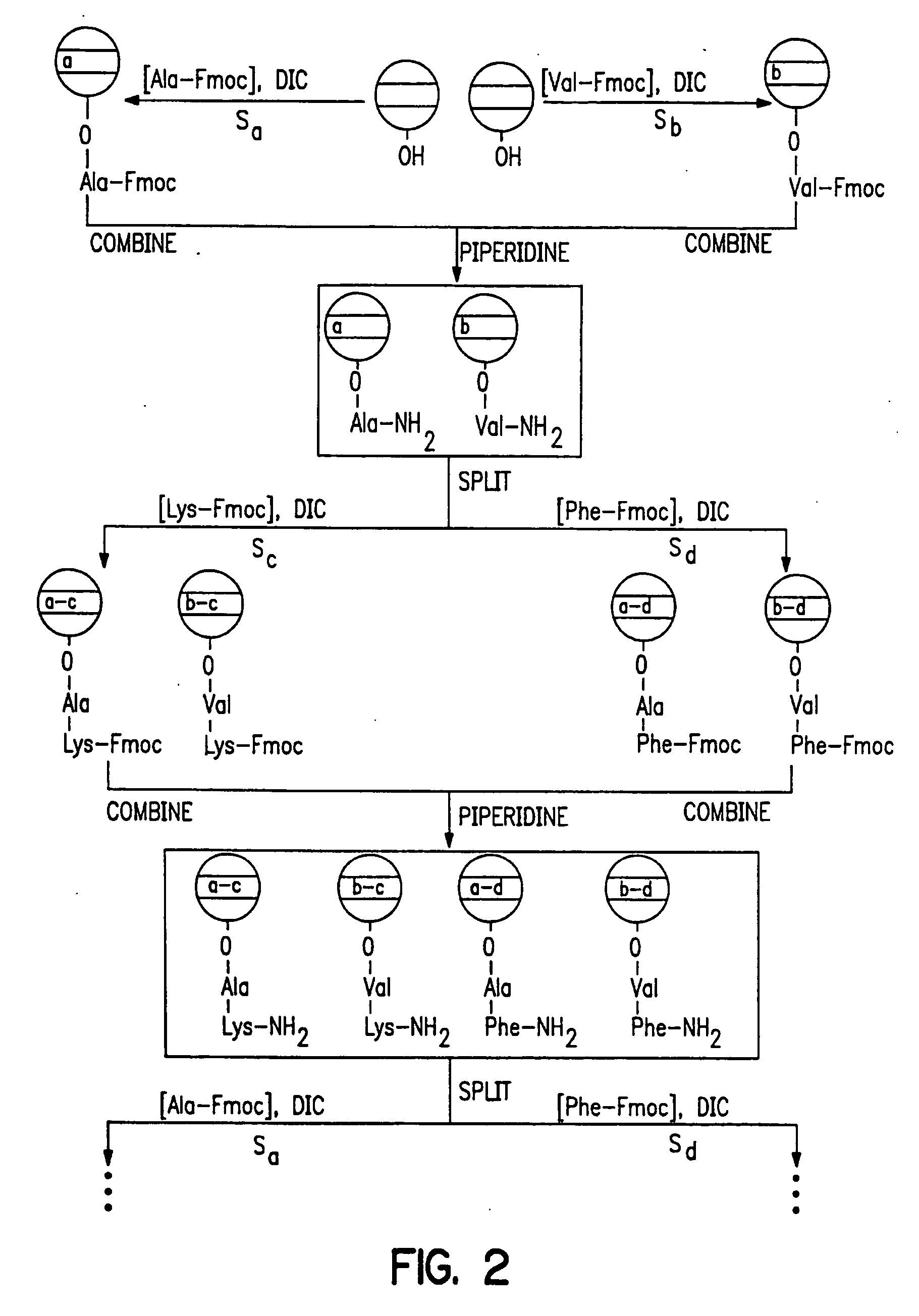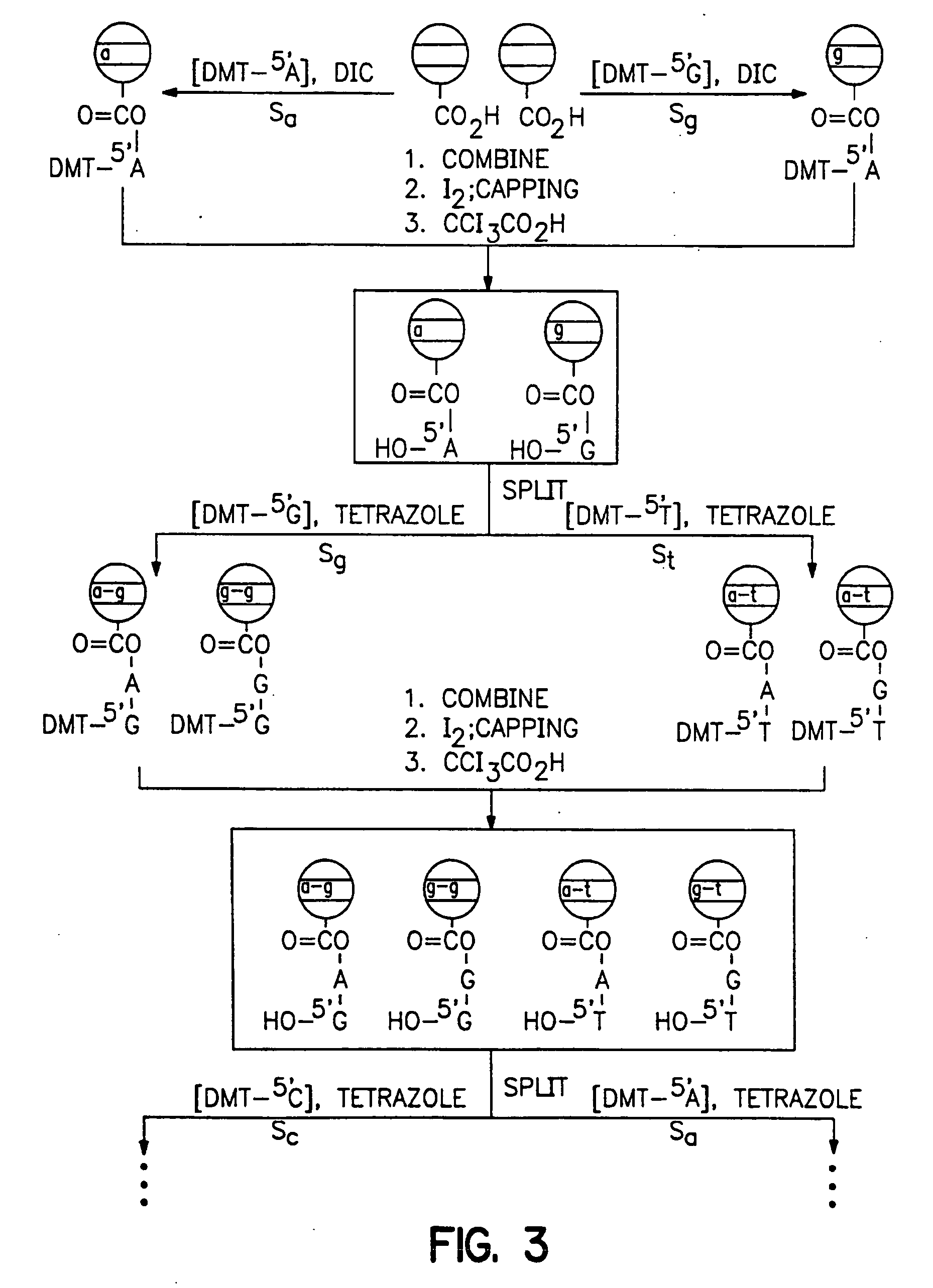Encoded solid supports for biological processing and assays using same
- Summary
- Abstract
- Description
- Claims
- Application Information
AI Technical Summary
Benefits of technology
Problems solved by technology
Method used
Image
Examples
example 1
Formulation of a Polystyrene Polymer on Glass and Derivatization of Polystyrene
[0450] A glass surface of any conformation [beads for exemplification purposes (1)] that contain a selected memory device that coat the device or that can be used in proximity to the device or subsequently linked to the device is coated with a layer of polystyrene that is derivatized so that it contains a cleavable linker, such as an acid cleavable linker. To effect such coating a bead, for example, is coated with a layer of a solution of styrene, chloromethylated styrene, divinyl benzene, benzoyl peroxide [88 / 10 / 1 / 1 / , molar ratio] and heated at 70° C. for 24 h. The result is a cross-linked chloromethylated polystyrene on glass (2). Treatment of (2) with ammonia [2 M in 1,4-dioxane, overnight] produces aminomethylated coated beads (3). The amino group on (3) is coupled with polyethylene glycol dicarboxymethyl ether (4) [n≈20] under standard conditions [PyBop / DIEA] to yield carboxylic acid derivatized be...
example 2
Construction of a Matrix with Memory
[0452] A matrix with memory was constructed from (a) and (b) as follows:
[0453] (a) A small (8×1×1 mm) semiconductor memory device [the IPTT-100 purchased from Bio Medic Data Systems, Inc., Maywood, N.J.; see, also U.S. Pat. Nos. 5,422,636, 5,420,579, 5,262,772, 5,252,962, 5,250,962, 5,074,318, and RE 34,936].
[0454] The memory device is a transponder [IPTT-100, Bio Medic Data Systems, Inc., Maywood, N.J.] that includes a remotely addressable memory [EEPROM]. The transponder receives, stores and emits radio frequency signals of different frequencies so that it can be remotely programmed with information regarding synthetic steps and the constituents of linked or proximate molecules or biological particles.
[0455] These devices are designed to operate without a battery, relying on the energy generated by the radio frequency pulses used in the encoding process. Also, it is important to note that additional sensors such as temperature [as in this c...
example 3
Microvessels
[0461] A. FIGS. 11-13
[0462]FIGS. 11-13 illustrate an embodiment of a microvessel 20 provided herein. The microvessel 20 is a generally elongated body with walls 22 of porous or semi-permeable non-reactive material which are sealed at both ends with one or more solid-material cap assemblies 42, 44. The microvessel 20 retains particulate matrix materials 40 and one or more recording devices 34. In the preferred embodiment illustrated in FIGS. 11-13, the recording device includes a shell 36 that is impervious to the processing steps or solutions with which the microvessel may come into contact, but which permits transmission of electromagnetic signals, including radiofrequency, magnetic or optical signals, to and from the recording media of the recording device.
[0463] The preferred microvessel 20 is generally cylindrically shaped and has two solid-material cap assemblies 42, 44. The cap assemblies may be formed of any material that is non-reactive with the solutions with...
PUM
| Property | Measurement | Unit |
|---|---|---|
| Size | aaaaa | aaaaa |
| Transparency | aaaaa | aaaaa |
| Fluorescence | aaaaa | aaaaa |
Abstract
Description
Claims
Application Information
 Login to View More
Login to View More - R&D
- Intellectual Property
- Life Sciences
- Materials
- Tech Scout
- Unparalleled Data Quality
- Higher Quality Content
- 60% Fewer Hallucinations
Browse by: Latest US Patents, China's latest patents, Technical Efficacy Thesaurus, Application Domain, Technology Topic, Popular Technical Reports.
© 2025 PatSnap. All rights reserved.Legal|Privacy policy|Modern Slavery Act Transparency Statement|Sitemap|About US| Contact US: help@patsnap.com



